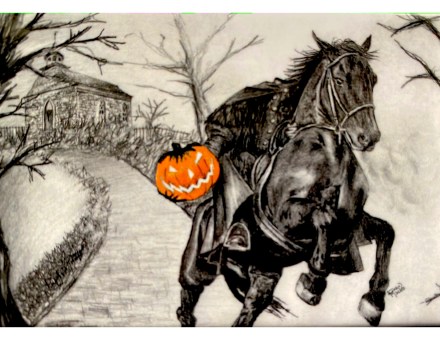America’s first author, Washington Irving who penned The Legend of Sleepy Hollow— celebrating its 200th anniversary this year—was born on April 3, 1783. Born in Sleepy Hollow myself, this legendary writer came into focus for me early, not only because of where I was born, but because he visited my childhood home. I grew up in the 1735 Dutch tenant farmhouse frequented by Irving, located at 740 South Broadway in Tarrytown, New York. This home survived the Revolutionary War, and holds a dark secret that Irving took advantage of for his literary pleasure.
Washington Irving America’s First Writer
With the serialized publication of The Sketch Book of Geoffrey Crayon, Gent. in 1819-1820, which included the short stories “The Legend of Sleepy Hollow” and “Rip Van Winkle,” Irving began to make a name for himself as an America-born writer while living in England. Born in New York City in 1783, six-year-old Irving met his namesake George Washington at his presidential inauguration in 1789. Despite being a lawyer, working the family merchant business, and dabbling in local politics, Irving desperately wanted to support himself as a writer. His first literary success came with letters and short articles for local publications before he moved to England after the war of 1812. While abroad his commercial successes grew but after seventeen years he came back to America in 1832 to settle at his new cottage on the Hudson River later dubbed Sunnyside.

Early in Irving’s career he wrote, “If the American public wish to have literature of their own they must consent to pay for the support of authors…For my part if I can succeed in writing so as deservedly to please the public and gain the good will of my countrymen it is all I care about—I only want money enough to enable me to keep on my own way and follow my own taste and inclination.”
But the story everyone remembers him for is that of Ichabod Crane and the Headless Horseman of Sleepy Hollow. “The Legend of Sleepy Hollow” was one of the last and the longest of his tales in the Sketch Book. There is an epigraph as introduction with four lines from Scottish poet James Thompson’s 1748 “The Castle of Indolence.”
A pleasing land of drowsy head it was,
Of dreams that wave before the half-shut eye;
And of gay castles in the clouds that pass,
For ever flushing round a summer sky.
Irving Biographer and Author Andrew Burstein claims, “Thompson’s poem speaks to Irving’s partiality for the malleable nature, lazy times, pastoral slumbers, and enchantment.” Burstein points out that the two lines before the epigraph conjure a more sinister picture:
A sable, silent, solemn forest stood;
Where nought but shadowy forms were seen to move.
The woodlands in the poem, “sent forth a sleepy horror through the blood.” Burstein writes, “all Irving had to do in his tale was make the “drowsy heads” headless. And so begins Irving’s romantic tale of how Ichabod wooed the lovely Katrina Van Tassel at the quilting frolic one Halloween night.
In the bosom of one of those spacious coves which indent the eastern shore of the Hudson, at the broad expansion of the river dominated by the ancient Dutch navigators the Tappan Zee, and where they always prudently shortened sail, and implored the protection of St. Nicholas when they crossed, there lies a small market town…
The Legend takes place around the same time Rip Van Winkle wakes up from his long slumber, about the time that George Washington becomes America’s first president and Washington Irving meets him. Burstein notes that according to Irving, this tale takes places in two locales, in “Tarry Town” a name set by “good housewives” because their husbands were prone to “linger about the village tavern on market days” and the “sequestered glen” of Sleepy Hollow where once again, a “drowsy, dreamy influence seems to hang over the land.” Irving knew that the early Dutch settlers still believed in the stories of ghosts and witches and by the American Revolution these cultural references were well known.
Early in the American revolution around 1775, the British government hired mercenaries from the Hesse region of Germany to supplement British troops. The patriots saw this as an act of terrorism by King George III who ruled the colonies. The German-speaking Hessians were known as Europe’s most blood thirsty army. According to a Revolutionary War diary the Hessians put their captors to immediate death while parents worried that Hessians would capture their children and eat them. With this kind of local lore still fresh in the minds of Americans, making the headless horseman a Hessian made perfect sense for Irving’s romantic ghost story.
An Historic Landmark
John Forkel was known to be a best friend of Irving. He was a cobbler and set up his shop in my childhood home in 1842. With the Forkel family the house gains an even greater historical significance beyond George Washington riding by during a parade on South Broadway, then the Albany Post Road, or Irving stopping by to get shirts made by his daughter.

There is a newspaper article which states that Forkel’s father was a Hessian solider who deserted and stayed in America during the Revolutionary War. It also stated that Forkel’s property contained five Hessians who were shot and killed by colonial militiamen. They were quickly buried beneath the apple orchard to the north of the house. This would be the same apple orchard where I once played as a toddler with my dog and cat. I like to believe that Irving frequented Forkel’s house not only for friendship, but to visit with his literary ghosts in person.













